Conradina
Conradina is a genus of flowering plants in the mint family, Lamiaceae.[1] Its common name is false rosemary, or rarely, short leaf rosemary. There are 7 species of Conradina, all native to the southeastern United States.[2] Conradina verticillata grows on the Cumberland Plateau in Kentucky and Tennessee.[3] The other five grow mainly in Florida. All of the species are closely related and there is some doubt about whether they are all separate.[2] Most species occupy xeric habitats with well-drained soils composed of white sand. The genus Conradina was established by Asa Gray in 1870.[4] It was named for the American botanist Solomon White Conrad.[5]
| Conradina | |
|---|---|
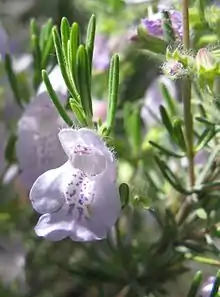 | |
| False rosemary (Conradina canescens). Note hairs on flower calyxes. | |
| Scientific classification | |
| Kingdom: | Plantae |
| Clade: | Tracheophytes |
| Clade: | Angiosperms |
| Clade: | Eudicots |
| Clade: | Asterids |
| Order: | Lamiales |
| Family: | Lamiaceae |
| Subfamily: | Nepetoideae |
| Tribe: | Mentheae |
| Genus: | Conradina Asa Gray |
| Type species | |
| Conradina canescens | |
False rosemary is adapted to dunes and open, scrubby areas. It is a woody perennial shrub, often with masses of white to lavender blooms in the early spring or fall. These blooms attract several species of bees. Conradina often has a scrubby appearance; however some plants seem to have a denser habitus. Conradina is found growing in association with sand pines and oaks, and may be a pioneer species in disturbed areas. Terpenes released from false rosemary are allelopathic, and suppresses the growth of grasses. This is thought to help prevent wildfires. The plants are commonly up to 1 m (3.3 ft) in height.
False rosemary has been suggested as a landscaping plant for xeriscaping because it is drought tolerant and grows well with little water, even in poor soils.
False rosemary has flowers and scent similar to those of Rosmarinus officinalis.
Until recently, limited scientific study had been published on culinary, medicinal or other properties of Conradina, but it has been shown to be a potential source for numerous essential oils and other compounds.[6]
Apart from Conradina verticillata, which is a triploid,[7] all of the species of Conradina are diploid and have a haploid chromosome number of 12. Conradina has been the subject of genetic research.[8]
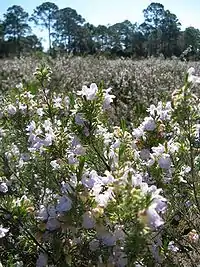
Species
| Image | Scientific name | Common Name | Distribution |
|---|---|---|---|
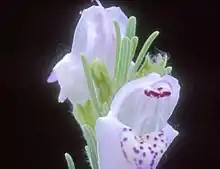 | Conradina brevifolia | Shortleaf false rosemary | This species grows in Polk and Highlands counties on the Lake Wales Ridge in Central peninsular Florida. It is listed as federally endangered species. |
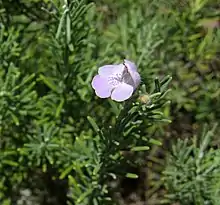 | Conradina canescens | False rosemary | This species is found along the gulf coast of Mississippi, Alabama and Florida, as well as in the sand hills of central Florida.[3] It is the most common and widespread species in the genus. |
| Conradina cygniflora | Described in 2009, known only from Putnam County, Florida. | ||
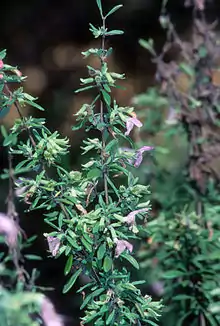 | Conradina etonia | Etonia rosemary | Verified in only Putnam County, Florida. A federally endangered species. |
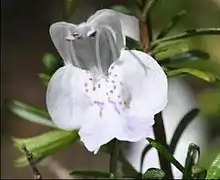 | Conradina glabra | Apalacicola false rosemary | Found only in Liberty county, Florida. Listed as a federally endangered species. |
_(8224712105).jpg.webp) | Conradina grandiflora | Largeflower false rosemary | This species grows in counties along the Atlantic coast of Florida. It is listed as a threatened species in the state of Florida. |
 | Conradina verticillata | Cumberland false rosemary | Listed as federally threatened, this species occupies the sandy soil of cobble bars along rivers of the Cumberland Plateau in Kentucky and Tennessee. |
Affinities
Conradina is one of the southeastern scrub mints. This group consists of Dicerandra, Stachydeoma, Piloblephis, Conradina, and four species of the polyphyletic genus Clinopodium that will eventually be transferred out of that genus. All are shrubs except Dicerandra. They are indigenous to the southeastern United States. Conradina is distinguished from the others by a sharply bent corolla tube.[9]
References
- Raymond M. Harley, Sandy Atkins, Andrey L. Budantsev, Philip D. Cantino, Barry J. Conn, Renée J. Grayer, Madeline M. Harley, Rogier P.J. de Kok, Tatyana V. Krestovskaja, Ramón Morales, Alan J. Paton, and P. Olof Ryding. 2004. "Labiatae" pages 167-275. In: Klaus Kubitzki (editor) and Joachim W. Kadereit (volume editor). The Families and Genera of Vascular Plants volume VII. Springer-Verlag: Berlin; Heidelberg, Germany. ISBN 978-3-540-40593-1
- Christine E. Edwards, Walter S. Judd, Gretchen M. Ionta, and Brenda Herring. 2009. "Using Population Genetic Data as a Tool to Identify New Species: Conradina cygniflora (Lamiaceae), a New, Endangered Species from Florida". Systematic Botany 34(4):747-759.
- Alan S. Weakley. "Conradina" pages 745-746. In: Flora of the Carolinas, Virginia, and Georgia (title varying with update). (see External links below).
- Asa Gray. 1870. Proceedings of the American Academy of Arts and Sciences 8:294.
- Umberto Quattrocchi. 2000. CRC World Dictionary of Plant Names volume I. CRC Press: Boca Raton; New York; Washington, DC;, USA. London, UK. ISBN 978-0-8493-2675-2 (vol. I). (see External links below).
- Brian P. Quinn, Ulrich R. Bernier, and Matthew M. Booth. 2007. "Identification of compounds from Etonia rosemary (Conradina etonia)". Journal of Chromatography A 1160(2007):306–310. (see External links below).
- USFWS. Conradina verticillata (Cumberland Rosemary) determined to be threatened. Federal Register November 29, 1991.
- Home Page of Christine E. Edwards. (see External links below).
- Christine E. Edwards, David Lefkowitz, Douglas E. Soltis, and Pamela S. Soltis. 2008. "Phylogeny of Conradina and related southeastern scrub mints (Lamiaceae) based on GapC Gene Sequences". International Journal of Plant Sciences 169(4):579-594. doi:10.1086/528758
Sources
- (1) FNAI. 2000. Field Guide to the Rare Plants and Animals of Florida online. Florida Natural Areas Inventory.
- (2) Godfrey, R. K. 1988. Trees, shrubs, and woody vines of northern Florida and adjacent Georgia and Alabama. Athens, GA: University of Georgia Press.
External links
![]() Media related to Conradina at Wikimedia Commons
Media related to Conradina at Wikimedia Commons
- Flora of the Carolinas, Virginia and Georgia
- Conradina In: Proceedings of the American Academy of Arts and Sciences At: Biodiversity Heritage Library
- CRC World Dictionary of Plant Names: A-C At: Botany & Plant Science At: Life Science At: CRC Press
- Compounda from Conradina etonia
- Homepage of Christine E. Edwards
- U.S. Department of Agriculture Plant Database
- Florida Plant Atlas
- Center for Plant Conservation National; Collection of Imperiled Plants